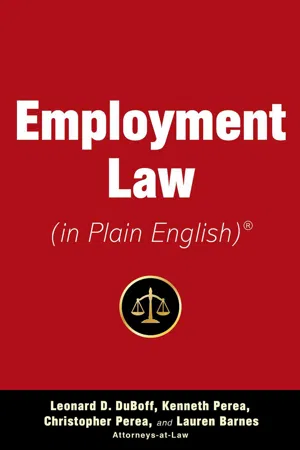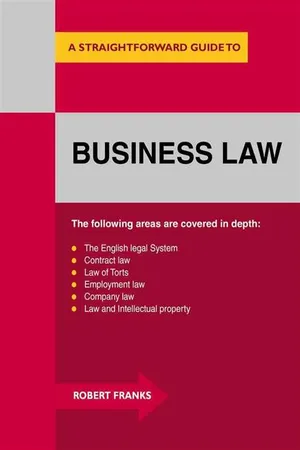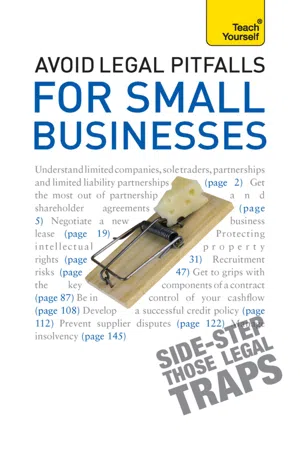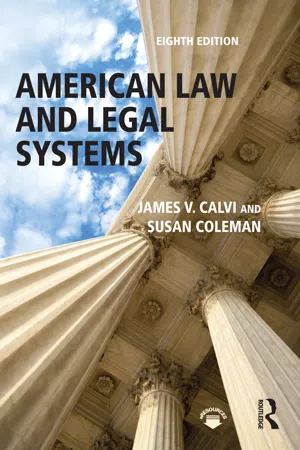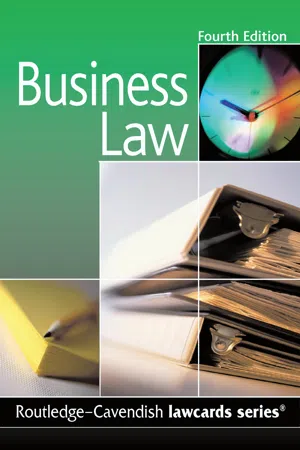Contracts
Contracts are legally binding agreements between two or more parties that outline the terms and conditions of a business arrangement. They can cover a wide range of transactions, from the sale of goods and services to employment relationships. Contracts typically include details such as the parties involved, the scope of work, payment terms, and any applicable legal provisions.
8 Key excerpts on "Contracts"
- eBook - ePub
- Leonard D. DuBoff, Kenneth A. Perea, Christopher Perea, Lauren Barnes(Authors)
- 2021(Publication Date)
- Allworth(Publisher)
...CHAPTER 3 Basics of Contracts Contracts are an essential part of virtually every business for both employees and employers. Clearly, the entire field of contract law cannot be covered here, but, by becoming aware of some of the ramifications of contract law, you will see where you need to be cautious. In this chapter we will cover contract fundamentals. In later chapters we present specific kinds of employment Contracts. CONTRACT BASICS A contract is a legally binding promise or set of promises. The law requires that the parties to a contract perform the promises they have made to each other. In the event of nonperformance—usually called a breach—the law provides remedies to the injured party. For the purposes of this discussion, it will be assumed that the contract is between two people, though it frequently involves business organizations, as well. It should be noted that when business organizations are involved, there are additional considerations, such as whether the person acting on behalf of the business has appropriate authority, how that authority must be evidenced and, regardless of authority, whether that individual’s act will be deemed within the appropriate scope of the business. These issues complicate the analysis. You should discuss these issues with your attorney. The three basic elements of every contract are the offer, the acceptance, and the consideration. To illustrate these elements, suppose a human resources manager meets with a prospective employee and explains what employment opportunities are available in the company (the offer). The prospective employee says that the job presented is perfect and acceptable (the acceptance). They agree on a salary (the consideration). That is the basic framework, but a great many variations can be played on that theme. TYPES OF Contracts Contracts may be express or implied. They may be oral or written...
- eBook - ePub
Business Law
A Straightforward Guide
- (Author)
- 2014(Publication Date)
- Straightforward Publishing Digital(Publisher)
...Ch. 1 BUSINESS LAW-THE LAW OF CONTRACT Underpinning all Contracts are four main principles: 1) A contract is an agreement between the parties to that contract-one person makes an offer and the other accepts that offer 2) Both parties have an intention to be legally bound by the agreement-this is usually known as an intention to create legal relations 3) Parties to the agreement need to be absolutely clear as to the terms of the agreement – this is the main area of contention with Contracts, as we will see laterc4) There must be consideration provided by each of the parties to the contract – this means that one person promises to give or deliver and the other promises to pay. The offer and the payment – either monetary or in kind - is the consideration. When making a contract, or entering into a contract all parties to the contract must have the legal capacity to enter into a contract. Very importantly, a contract, in most cases, does not have to be in writing – a piece of paper is not necessary, the agreement and evidence of that agreement forms the basis of contract. There are a few important exceptions, including Contracts relating to interests in land (Law of property (Miscellaneous Provisions) Act 1989, s 2(1)) and consumer credit (Consumer Credit Act 1974). Other factors affecting formation include: • Form-the way the contract is created (e.g. the sale of land can only be made in the form of a deed) Form is an issue with specialty Contracts but not with simple Contracts • Privity of contract and the rights of third parties-generally a contract is only enforceable by or against a party to it, subject to exceptions and certain third party rights are now protected in the Contracts (Rights of Third Parties) Act 1999. The nature of Contracts – unilateral and bilateral Contracts The majority of Contracts entered into are known as Bilateral Contracts. This quite simply means that each party to a contract agrees to take on an obligation...
- eBook - ePub
Avoid Legal Pitfalls for Small Businesses
An essential reference guide to law and litigation for SMEs
- Bevans Solicitors(Author)
- 2012(Publication Date)
- Teach Yourself(Publisher)
...5 Contracts: an overview In this chapter you will learn about: Contracts and contract law in general terms the key components of a contract – agreement, form, intention and consideration the key factors to consider when looking at or entering into Contracts. Definition Perhaps surprisingly the law does not provide a formal definition of what a contract is. The definition we shall be using for the purpose of this chapter is as follows and is the very root of what a contract is: A contract is an agreement which the parties intend to be legally binding. The cardinal principle this definition embodies is: freedom of contract. We will see that it also encompasses a number of substantive elements and these will be described below. Parties to a contract Before looking at the fundamental components of Contracts, it is worth spending some time considering what we mean by ‘the parties’. A contract must have at least two parties. It is not possible to have a sole party to a contract; it is not possible to sue oneself. The vast majority of Contracts that small businesses come across or enter into are between two parties and are described as ‘bilateral’ or ‘bipartite Contracts’. There are numerous Contracts between more than two parties. However, to illustrate the key principles of contract law, we will confine ourselves to bilateral Contracts. The general principles will apply to all types of Contracts irrespective of the numbers of the parties. ‘The party’ is the entity which has the legal personality and power to enable it to enter into a contract. This capacity is specifically described as contractual capacity. For a legal person to be able to enter into a contract, that person must have full contractual capacity. There are exceptions that relate to specific and certain categories of individuals, authorities and companies. The contractual capacity of an individual is restricted if he/she is a minor or if he/she has a mental disorder or is intoxicated...
- eBook - ePub
- James V. Calvi, Susan Coleman(Authors)
- 2016(Publication Date)
- Routledge(Publisher)
...CHAPTER 11 Contracts Contracts are binding agreements that have legal consequences and can be enforced in court. Noted contract scholar Samuel Williston defined a contract as “a promise, or set of promises, for breach of which the law gives a remedy, or the performance of which the law in some way recognizes as a duty.” 1 Contracts provide stability and allow society to carry out its transactions in an orderly fashion; however, Contracts are not limited to serious business ventures. For example, siblings who enter into bargains to divide the household chores between them are creating Contracts. While some Contracts are rather elaborate and formal, others are informal and even implied. Ensuring stability and certainty is the quintessential goal of Contracts. Those who enter into these agreements do so with the knowledge that failure to live up to their part of the bargain may result in a court order for specific performance or for monetary damages as well as damage to their reputation in the community. The importance of contract stability is emphasized by Article I, § 10 of the U.S. Constitution, which provides that “No State shall … pass any … Law impairing the Obligation of Contracts.” In earlier days, freedom of contract was virtually uncircumscribed by government restrictions; people contracted as they pleased, with the only real restraint being that Contracts for illegal purposes were not enforceable by the courts. For example, government Contracts secured by bribing a public official cannot be enforced by the corporation offering the bribe. That rule is still valid; however, other restrictions have been added...
- eBook - ePub
Contracts for Your Business
A straightforward guide to contracts and legal agreements
- Charles Boundy(Author)
- 2012(Publication Date)
- Harriman House(Publisher)
...Chapter 1. Basics Contract 1.1 What is a contract? In practical terms, a contract is a legally binding agreement. This requires: actual agreement on all the essential terms of the deal; sufficient clarity and certainty as to those terms; an agreed price or other exchange value (called ‘consideration’); the intention to have a legal commitment. For the sake of simplicity it is generally assumed that there are only two parties to the transactions referred to in this book. The same principles nevertheless broadly apply to multi-party Contracts. 1.2 What about the need for agreement? Reaching agreement – Agreement is arrived at by one party making an offer to do something for the other on stated terms and the other accepting that offer. If the first offer is refused, that may be the end of the matter. If a counter-offer is made, such as a different price or other terms, that counter-offer cancels the original offer and creates a revised offer on the suggested new terms. That process can continue until the terms match. Stan Smith offers to sell Jenny Jones a computer system for her new business. He quotes a price, a delivery date and a fee for installation, commissioning and training. Jenny Jones thanks Smith for his offer, but says that whilst she would like to deal with him, she can get a better deal. That could be the end of the story. However, Jones goes on to say that she would buy from Smith if he reduced his price by 10% and included the additional costs within it. That is a counter-offer, open for Smith to accept or not. Note that if Smith refuses, Jones cannot go back to his original offer (unless Smith agrees), as this was cancelled by her counter offer. Smith might back away, but if he agrees Jones’s proposal, that can create a contract...
- eBook - ePub
- Kenny Chin(Author)
- 2014(Publication Date)
- Routledge-Cavendish(Publisher)
...4 Contract Law You should be familiar with the following areas: • the essentials of contract and the effects of the absence of them • rules relating to offer, acceptance and invitation to treat • use of postal and other means of communication on offer and acceptance • rules of consideration • distinction of legal intention to contract on domestic and social agreements • capacity of minors to make Contracts and the effect of the Minors’ Contracts Act 1987 • discharge of contract by frustration and the effects of the Law Reform (Frustrated Contracts) Act 1943 • breach of contract and the remedies • consumer contract and related provisions under various statutes • duties of employer and employee, sex and racial discrimination in employment Introduction A contract is an agreement between two or more parties, who promise to give and receive something from each other and who intend that the agreement be legally binding. Except for some special Contracts, for example, sale of a house, there is no general legal requirement that a contract has to be in writing. Verbal Contracts are as enforceable as written Contracts. The problem with verbal Contracts is not on validity but on evidence. When nothing is recorded in black and white it is difficult to prove who has said what. Contract law is categorised in the law of obligation. A contract creates a legal obligation between the contracting parties. When one party has not fulfilled, or is not going to fulfil the obligation, he can be sued for breach of contract. The court will help the innocent party by either ordering damages suffered to be compensated, compelling the party in breach to perform the contract (specific performance order) or prohibiting the wrongdoer to act in a way which would cause further breaches (injunction order). It is therefore important to know how and when a binding agreement has been created...
- eBook - ePub
- Routledge-Cavendish(Author)
- 2009(Publication Date)
- Routledge-Cavendish(Publisher)
...4 Contract The formation of Contracts The essential elements of a binding contractual agreement are as follows: • offer; • acceptance; • consideration; • capacity; • intention to create legal relations; • no vitiating factors. The first five of these elements must all be present and there must be an absence of any initiating factors. Offer An offer is a promise, which is capable of acceptance, to be bound on particular terms. An offer must be distinguished from the following: • a mere statement of intention (Kleinwort Benson v Malaysian Mining Corp (1989)); • a mere supply of information (Harvey v Facey (1893)); • an invitation to treat. This is an invitation to others to make offers. An invitation to treat cannot be accepted in such a way as to form a contract, nor can the person extending the invitation be bound to accept any offers made to them. Examples of invitations to treat are: – the display of goods in a shop window (Fisher v Bell (1961)); – the display of goods on the shelf of a self-service shop (Pharmaceutical Society of Great Britain v Boots Cash Chemists (1953)); – a public advertisement (Partridge v Crittenden (1968)); – a share prospectus: contrary to common understanding, such a document is merely an invitation to treat, inviting people to make offers to subscribe for shares in a company; – auctions operate on the basis of the auctioneer inviting and accepting offers from the bidders. Offers to particular people An offer may be made to a particular person, to a group of people, or to the world at large...
- eBook - ePub
- Chris Turner(Author)
- 2014(Publication Date)
- Routledge(Publisher)
...4 Formation of a contract: Intention to create legal relations AIMS AND OBJECTIVES After reading this chapter you should be able to: Understand the purpose of the rule on intention Distinguish between social and domestic agreements and business arrangements Critically analyse the area Apply the law to factual situations and reach conclusions 4.1 The character and purpose of the rule We all regularly make arrangements with each other, and we may even be doing things in return for something, and this seems as though there is consideration too and that the agreement may therefore be binding. However, not every agreement that is made includes an intention that if we fail to keep to the agreement the other party should be able to sue us for breach of the agreement. JUDGMENT As Lord Stowell remarked in Dalrymple v Dalrymple (1811) 2 Hag Con 54 at 105: ‘Contracts should not be … the sports of an idle hour, mere matters of pleasantry and badinage, never intended by the parties to have any serious effect whatever.’ It would in any case not be sensible for the courts to be filled with actions on all of the broken promises that are ever made. Parents make promises of pocket money to their children who may expect the pocket money to be paid regularly. Husbands make promises to their wives that they never keep. Boyfriends and girlfriends make arrangements to meet that they fail to keep. It would fill the courts and hardly be sensible in each broken promise of this type to allow the disappointed parties to be able to sue even if it is upsetting and morally blameworthy when they are broken. The law makes a sensible compromise by assuming that in certain situations we would usually not intend the agreement to be legally binding, while in others we usually would...
